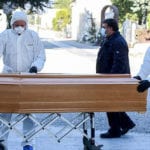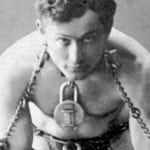 Mysteries
Mysteries  Mysteries
Mysteries  History
History 10 Surprising Stories About the Texas Rangers
 Humans
Humans 10 Philosophers Who Were Driven Mad by Their Own Theories
 Miscellaneous
Miscellaneous 10 Video-Game-Worthy Weapons and Armors from History
 Weird Stuff
Weird Stuff 10 Psychics Who Accurately Predicted Wartime Events
 The Arts
The Arts 10 Pieces of Art Inspired by a Broken Heart
 Health
Health 10 Science Fiction-Sounding New Medical Treatments
 History
History 10 Surprising Facts About the Father of Submarine Warfare
 Space
Space Ten Astonishing New Insights into Alien Worlds
 Weird Stuff
Weird Stuff 10 Bizarre Summer Solstice Rituals Still Practiced Today
 Mysteries
Mysteries Top 10 Haunting Facts About the Ghost Ship MV Alta
 History
History 10 Surprising Stories About the Texas Rangers
 Humans
Humans 10 Philosophers Who Were Driven Mad by Their Own Theories
Who's Behind Listverse?

Jamie Frater
Head Editor
Jamie founded Listverse due to an insatiable desire to share fascinating, obscure, and bizarre facts. He has been a guest speaker on numerous national radio and television stations and is a five time published author.
More About Us Miscellaneous
Miscellaneous 10 Video-Game-Worthy Weapons and Armors from History
 Weird Stuff
Weird Stuff 10 Psychics Who Accurately Predicted Wartime Events
 The Arts
The Arts 10 Pieces of Art Inspired by a Broken Heart
 Health
Health 10 Science Fiction-Sounding New Medical Treatments
 History
History 10 Surprising Facts About the Father of Submarine Warfare
 Space
Space Ten Astonishing New Insights into Alien Worlds
 Weird Stuff
Weird Stuff 10 Bizarre Summer Solstice Rituals Still Practiced Today
Top 10 Athletes Who Died Competing
We always expect athletes to give it their all. At their best, sports competitions showcase both inherent physical talents and the virtue of hard work. When our teams win or an athlete takes gold, it examples the culmination of God-given ability and tireless training.
But sometimes tragedy strikes before the final bell or finish line. Sometimes athletes take the field with the intention of giving it everything, and end up with nothing left to give.
Here are ten athletes who literally left it all on the field.
10 Of The World’s Most Bizarre Sports
10 A Lethal Leap: Kevin Dare

Pole vaulting is considered the most dangerous track & field sport, as it involves catapulting oneself more than a dozen feet in the air with no protective gear. While impalements certainly happen – last year, a college athlete needed 18 stitches after a pole pierced his scrotum – those injuries aren’t usually lethal. Instead, the likeliest way to die pole vaulting is failing to clear the bar, missing the landing pad and smacking the ground headfirst.
One example is particularly horrific. In February 2002, 19-year-old Penn State sophomore Kevin Dare was competing in the track & field championships for the Big Ten, a prominent college sports conference. Dare sprinted down the runway with the bar set at 15 feet 7 inches — a relatively easy height as he’d just cleared 16 feet in practice. He planted the pole into the steel setting at the base of the takeoff point and launched himself, the pole bending then rebounding as Dare was carried upward. With the pole completely vertical, Dare kicked out as though he’d cleared the bar. Only he hadn’t.
”He swung upside down and sort of stalled with his jump,” assistant coach Mario Sategna said. ”It looked like he became disoriented and didn’t know where he was.”
Dare let the pole go and plunged straight down, headfirst, and crushed his skull on the eight-inch-deep steel casing where he’d planted the pole on takeoff. Spectators screamed and medics rushed to Dare’s aid, but he was pronounced dead shortly after arriving at a hospital.
9 Checked Out: Bill Masterton
For a sport as notoriously violent as ice hockey, it’s surprising that fatalities aren’t more frequent. But they certainly do occur. In fact, less than a month ago a 19-year-old Russian junior league hockey player named Timur Faizutdinov collapsed after being struck in the head by the puck. He died on March 16.
Still, hockey deaths are rare considering not only its high-velocity collisions but semi-legal fisticuffs. The last notable fight-caused death was in 2009, when a player in Canada’s Ontario Hockey League named Don Sanderson struck his head on the ice during an altercation.
Incredibly, there has been just one fatal on-ice incident in the history of the sport’s most prominent organization, Canada-USA’s National Hockey League. On January 13, 1968, Minnesota North Stars center Bill Masterton was racing up the ice at full speed. As he passed to a teammate, two players with the Oakland Seals converged on him with a fierce yet legal check.
Like many players at the time, Masterton wasn’t wearing a helmet. His opponents’ combined hit sent him flying backwards; many witnesses believe Masterton was unconscious before even hitting the ice, which he impacted with such force it was audible from the bench. Bleeding from his nose, ears and mouth, he briefly came to and muttered “Never again, never again.” His statement proved prescient 30 hours later, when he died without ever regaining consciousness.
8 Foiled: Vladimir Smirnov
At the 1980 Olympics in Moscow, fencer Vladimir Smirnov won the gold medal in the individual men’s foil, as well as two other medals for team competitions. Proving his success wasn’t merely due to 65 nations (including must of the western world) boycotting those games, the following year he won the World Championships.
In July 1982, Smirnov was prepared to defend his title at the World Championships in Rome. Among his opponents was a West German fencer named Matthias Behr, who’d won the gold medal at the 1976 Olympics. The anticipated showdown began as the two champions jabbed, swiped, and deftly blocked each other’s attacks. Suddenly Behr lunged…
… and his sword broke. Behr’s jagged, thin blade sliced through the mesh of Smirnov’s face mask, and unfortunately didn’t stop there. It punctured Smirnov’s eye socket and lodged in his brain.
Smirnov fainted to the floor. He died nine days later, one of only seven fencers to die from competition-related injury. The accident led to sweeping changes in gear safety, including swords comprised of materials far less likely to break, tougher uniforms made of Kevlar and masks with stronger steel alloys to prevent penetration. Since Smirnov’s passing, there have been no deaths in high-level fencing.
7 Neck and Neck: Howard Glenn and Stone Johnson
In American sports, it’s well known that Chuck Hughes, a wide receiver for the Detroit Lions, is the only National Football League player to die on the field. During a contest against the Chicago Bears on October 24, 1971, Hughes collapsed following a play from a major heart attack. He died later that day.
However, the modern NFL is a combination of two leagues: the original National Football League and the since-absorbed American Football League. That organization saw two equally tragic yet largely forgotten fatalities.
In 1960, an offensive guard for the New York Titans (now the Jets) named Howard Glenn suffered what was considered a minor in-game injury. Leading into the ensuing week’s matchup, in hot and humid Houston against the Oilers (now, ironically, the Tennessee Titans), Glenn complained of headaches.
During one huddle, he confided “I don’t think I can make it,” but was encouraged to stick it out. Soon after, he was sandwiched by two defenders and needed to be helped back up. Glenn went to the bench and, after the game, the hospital, where he died. Remarkably, the cause of death was a broken neck. It’s unclear whether he suffered the injury in Houston or during the previous week’s game.
Three years later, a former Olympic sprinter named Stone Johnson was blocking during a kickoff return for the Kansas City Chiefs. A brutal hit left him instantly paralyzed with a broken neck, and he died the following week. Despite never playing in a regular season game – the tragedy happened during a preseason exhibition – Johnson’s #33 was retired.
6 Death by Ref? (David Browne)
Unsurprisingly, boxing has caused the most athlete deaths. While the majority are simply the nature of the sport, sometimes poor refereeing factors in mightily. For example, in 2017, Canadian heavyweight Tim Hague was getting completely trounced by his opponent, Adam Braidwood. Hague was floored five times in two rounds – the fifth and final fall leading to his death two days later. Letting the fight continue that long was questionable at best.
Perhaps the most problematic case of death by ref occurred in Australia. On September 11, 2015, super featherweight David Browne showed early promise before fading in the later rounds against Filipino fighter Carlo Magali. By the 11th and penultimate round, Browne was taking a pummeling.
As featured on 60 Minutes Australia, following that round Browne – who was hit with several punches after the bell due to the ref’s inattentiveness – could barely find his corner to sit down. He had a concussion so severe that a coroner’s report determined “he was unable to adequately defend himself or continue the contest.” His corner stalled for time, since despite Browne’s wooziness he was likely to win by decision if he survived the final round.
He didn’t. The bell for round 12 rang, and the ref actually pulled Browne out of his corner into the center of the ring. Defenseless, Browne suffered a barrage of blows so brutal the footage has been removed from the Internet. He died three days later.
5 A Rugby Death Spree in… France?
Rugby is more associated with English-speaking nations – including New Zealand and Wales, where it’s the national sport – but recently a string of fatalities occurred on pitches across France.
On November 24, 2018, 23-year-old ESIREM Graduate School player Nathan Soyeux was injured by a fierce tackle. After initially sitting up and speaking with medics, he lost consciousness and was hurried to a hospital in Dijon. Doctors placed Soyeux in an induced coma for two weeks, but his health deteriorated when they tried bringing him out of it. He died in early January 2019.
Worrisomely, Soyeux was the FOURTH Frenchman to die from a rugby injury in just eight months. His fatal blow came just a few weeks after 18-year-old Stade Francais Academy flanker Nicolas Chauvin died after breaking his neck. Just two months before Chauvin, pro rugby player Louis Fajfrowski collapsed and died in his Aurillac club’s locker room. A heavy tackle had forced him from the field, and an autopsy cited his cause of death as “lethal fibrillation” – meaning a harsh blow to his chest caused a lethal change to his heartbeat rhythm.
Prior to Fajfrowski there was 17-year-old amateur Adrien Descrulhes, who died in May 2018 after receiving a crushing blow to the head. Combined, the deaths prompted France to adopt new rules aimed at limiting dangerous pileups, which other countries are also now considering.
4 A Heart-stopping Blow: Bruno Boban
In a sport that often requires athletes to run several miles over the course of a 90-minute game, it’s not surprising that most soccer-related deaths involve overworked hearts. Footballers have suffered fatal cardiac arrests on the pitch several times; most recently, in January 24-year-old Alex Apolinario, a Brazilian playing for Portugal’s FC Alverca, went into cardiorespiratory arrest on the field and died soon thereafter.
In 2016, a Cameroonian pro footballer named Patrick Ekeng died during a game in Bucharest, Hungary after collapsing on the field. Disturbingly, the 26-year-old midfielder went from fully participating one moment to completely sprawled out on his back the next.
However, another recent soccer death was far more freakish. In 2018, a 25-year-old Croatian soccer player died on the field after being struck by the ball in his chest. Initially following the hit, Bruno Boban, a forward with the Croatia League’s NK Marsonia, continued standing – even jogging on the pitch for several seconds.
Then he collapsed. Medical personnel tried to revive him for 40 minutes but were unsuccessful. An autopsy determined that the ball’s violent impact caused Boban’s heart to seize and ultimately fail.
3 Goalkeeper Turns Cryptkeeper: Akli Fairuz
Though the mileage on their hearts is minimal, soccer goalkeepers frequently find themselves in precarious positions, often chasing a ball at full speed while an opponent or teammate is pursuing the same ball from the opposite direction. Such was the case in 2017 for Choirul Huda, a goalkeeper for Persela in the Indonesia Super League, who inadvertently collided with a teammate while attempting to field an errant ball. Huda’s head was bashed into the ground. He briefly clutched his face and jaw, then collapsed, unconscious. He died a short while later of head trauma.
But during a May 10, 2014 contest in the Indonesian Premier League, the goaltender was the one doing the damage – and far less excusably. When a looping shot ricocheted off the chest of PSAP Sigli goalkeeper Agus Rahman, it bounded directly into the path of Persiraja forward Akli Fairuz.
The two raced for the ball, and Fairuz got there first. But as Fairuz handled and ultimately scored off the rebound, Rahman dove feet-first, lifted his cleats and kicked Fairuz directly in the midsection, spikes up in something resembling a WWE drop-kick. Both benches cleared and scuffles ensued as Fairuz’s teammates took umbrage with Rahman’s cheap shot.
Fairuz seemed OK, and even watched the rest of the match from the sidelines. Afterwards, though, severe internal injuries were discovered at a hospital. He underwent surgery but died. Adding insult to mortal injury, the goal he scored was disallowed.
2 A Dead Man Ends Baseball’s Dead Ball Era: Ray Chapman
Babe Ruth’s bonanza of home runs may not have happened were it not for the death of a less notable player.
Before 1921, baseballs were often in play for several innings, until they essentially unraveled. Fans had to return fouls rather than keep them as lucky souvenirs, and the balls themselves were loosely stitched and prone to scuffing and dirt buildup. The ball didn’t travel well, limiting offensive outputs and making home runs rarities.
Per Ken Burns’ classic documentary, this period, baseball’s “Dead Ball Era,” was defined by a “misshapen, earth-colored ball that traveled through the air erratically, tended to soften in the later innings and, as it came over the plate, was very hard to see.”
On August 16, 1920, the inevitable happened. With the Cleveland Indians’ Ray Chapman at bat, a submarine-style Yankees pitcher named Carl Mays threw a fastball high and inside. Wearing just a cap (protective batting helmets were still rare), Chapman failed to react, presumably unable to see it.
The sound of the ball striking Chapman’s skull was so loud, and the ball’s carom so defined, that Mays thought it hit the end of Chapman’s bat. So he fielded it and threw it to first base while Chapman lay in a crumpled heap in the batter’s box.
He died 12 hours later. The tragedy helped lead to a tighter, brighter and more frequently switched-out baseball, without which Ruth’s legendary blasts would have been far fewer and further between.
1 Sweet Kiss of Death: Frank Hayes
Twenty-two-year-old jockey Frank Hayes had never won a race before. In fact, calling him a jockey was a stretch, as he’d spent most of his brief career training horses rather than riding them.
His streak wasn’t likely to end on June 4, 1923 at Belmont Park in New York. Hayes was scheduled to compete in a steeplechase – a race featuring fence and ditch obstacles that horses must jump – and his steed, Sweet Kiss, was a 20-to-1 longshot. But on this day, Sweet Kiss stormed out of the gate, cleared obstacles with ease and crossed the finish line a head’s length in front of the runner-up. Hayes had won.
He’d also died. Somewhere in the middle of the race, Hayes suffered a fatal heart attack – a fact brought to light only when the horse’s owner came over to congratulate him. In the investigation that followed, it was suggested that Hayes’ cardiac arrest may have been brought on by his extreme efforts to meet the weight requirements.
“It was the first winning mount for Hayes,” wrote W.C. Vreeland in the Brooklyn Daily Eagle. “And the last.” More than anything, witnesses were amazed Hayes had remained in the saddle despite the violent, jump-and-land riding that steeplechase requires. He was buried three days later in his winning racing silks. The horse was deemed cursed and never raced again.
Top 10 Most Brutal Modern Fight Sports








